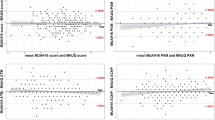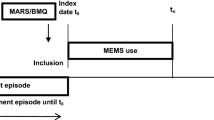Abstract
Study purpose was to revise and examine the validity of the Medication Adherence Self-Efficacy Scale (MASES) in an independent sample of 168 hypertensive African Americans: mean age 54 years (SD = 12.36); 86% female; 76% high school education or greater. Participants provided demographic information; completed the MASES, self-report and electronic measures of medication adherence at baseline and three months. Confirmatory (CFA), exploratory (EFA) factor analyses, and classical test theory (CTT) analyses suggested that MASES is unidimensional and internally reliable. Item response theory (IRT) analyses led to a revised 13-item version of the scale: MASES-R. EFA, CTT, and IRT results provide a foundation of support for MASES-R reliability and validity for African Americans with hypertension. Research examining MASES-R psychometric properties in other ethnic groups will improve generalizability of findings and utility of the scale across groups. The MASES-R is brief, quick to administer, and can capture useful data on adherence self-efficacy.




Similar content being viewed by others
References
Allegrante, J. P., & Marks, R. (2003). Self-efficacy in management of osteoarthritis. Rheumatic Diseases Clinics of North America, 29(4), 747–768. doi:10.1016/S0889-857X(03)00060-7. vi-vii.
American Heart Association. (2006). High blood pressure statistics. New York.
Bandura, A. (1977a). Self-efficacy: Toward a unifying theory of behavioral change. Psychological Review, 84(2), 134–139. doi:10.1037/0033-295X.84.2.191.
Bandura, A. (1997b). Self-efficacy: The exercise of control. New York: W.H. Freeman.
Bollen, K. A. (1989). Structural equations with latent variables. New York: Wiley.
Bosworth, H. B., Dudley, T., Olsen, M. K., Voils, C. I., Powers, B., Goldstein, M. K., et al. (2006). Racial differences in blood pressure control: Potential explanatory factors. American Journal of Medicine, 119(1), 70. e9-15.
Boutin-Foster, C., Ogedegbe, G. O., Ravenell, J. E., Robbins, L., & Charlson, M. E. (2007). Ascribing meaning to hypertension: A qualitative study among African Americans with uncontrolled hypertension. Ethnicity and Disease, 17(1), 29–34.
Burt, V. L., Cutler, J. A., Higgins, M., Horan, M. J., Labarthe, D., & Whelton, P. (1995). Trends in the prevalence, awareness, treatment, control of hypertension in the adult US population. Data from the health examination surveys, 1960-1991. Hypertension, 26(1), 60–69.
Catz, S. L., Kelly, J. A., Bogart, L. M., Benotsch, E. G., & McAuliffe, T. L. (2000). Patterns, correlates, and barriers to medication adherence among persons prescribed new treatments for HIV disease. Health Psychology, 19(2), 124–133. doi:10.1037/0278-6133.19.2.124.
Centers for Disease Control, Prevention. (2005). Racial/ethnic disparities in prevalence, treatment, and control of hypertension: United States, NHANES 1999–2002. MMWR. Morbidity and Mortality Weekly Report, 54, 7–9.
Choo, P. W., Rand, C. S., Inui, T. S., Lee, M. L., Cain, E., Cordeiro-Breault, M., et al. (1999). Validation of patient reports, automated pharmacy records, and pill counts with electronic monitoring of adherence to antihypertensive therapy. Medical Care, 37(9), 846–857. doi:10.1097/00005650-199909000-00002.
Cudeck, R., & Browne, M. W. (1992). Constructing a covariance matrix that yields a specified minimizer and a specified minimum discrepancy function value. Psychometrika, 57, 357–369. doi:10.1007/BF02295424.
Curtain, R. B., Walters, B. A. J., Schatell, D., et al. (2008). Self-efficacy and self-management behaviors in patients with chronic kidney disease. Advances in Chronic Kidney Disease, 15(2), 191–205. doi:10.1053/j.ackd.2008.01.006.
Gerin, W., Tobin, J. N., Schwartz, J. E., Chaplin, W., Rieckmann, N., Davidson, K. W., et al. (2007). The medication Adherence and Blood Pressure Control (ABC) trial: A multi-site randomized controlled trial in a hypertensive, multi-cultural, economically disadvantaged population. Contemporary Clinical Trials, 28(4), 459–471. doi:10.1016/j.cct.2007.01.003.
Gifford, A. L., Bormann, J. E., Shively, M. J., Wright, B. C., Richman, D. D., & Bozzette, S. A. (2000). Predictors of self-reported adherence and plasma HIV concentrations in patients on multidrug antiretroviral regimens. Journal of Acquired Immune Deficiency Syndromes, 23(5), 386–395.
Gorsuch, R. L. (1983). Factor analysis (2nd ed.). Hillsdale, NJ: Lawrence Earlbaum Associates.
Guadagnoli, E., & Velicer, W. F. (1988). Relation of sample-size to the stability of component patterns. Psychological Bulletin, 103(2), 265–275. doi:10.1037/0033-2909.103.2.265.
Hertz, R. P., Unger, A. N., Cornell, J. A., & Saunders, E. (2005). Racial disparities in hypertension prevalence, awareness, and management. Archives of Internal Medicine, 165(18), 2098–2104. doi:10.1001/archinte.165.18.2098.
Hu, L., & Bentler, P. M. (1999). Cutoff criteria for fit indexes in covariance structure analysis: Conventional criteria versus new alternatives. Structural Equation Modeling, 6, 1–55.
Hugen, P. W. H., Langebeek, N., Burger, D. M., Zomer, B., van Leusen, R., Schuurman, R., et al. (2002). Assessment of adherence to HIV protease inhibitors: Comparison and combination of various methods, including MEMS (electronic monitoring), patient and nurse report, and therapeutic drug monitoring. Journal of Acquired Immune Deficiency Syndromes, 30, 324–334.
Johnson, M. O., Chesney, M. A., Goldstein, R. B., Remien, R. H., Catz, S., Gore-Felton, C., et al. (2006). Positive provider interactions, adherence self-efficacy, and adherence to antiretroviral medications among HIV-infected adults: A mediation model. AIDS Patient Care and STDs, 20(4), 258–268. doi:10.1089/apc.2006.20.258.
Kirscht, J. P., & Rosenstock, I. M. (1977). Patient adherence to antihypertensive medical regimens. Journal of Community Health, 3(2), 115–124. doi:10.1007/BF01674233.
Liu, H., Golin, C. E., Miller, L. G., Hays, R. D., Beck, C. K., Sanandaji, S., et al. (2001). A comparison study of multiple measures of adherence to HIV protease inhibitors. Annals of Internal Medicine, 134(10), 968–977. see comment erratum appears in Ann Intern Med 2002 Jan 15;136(2):175.
Lord, F. M. (1980). Applications of item response theory to practical testing problems. Hillsdale, NJ: Lawrence Erlbaum Associates.
Lorig, K., Chastain, R. L., Ung, E., Shoor, S., & Holman, H. R. (1989). Development and evaluation of a scale to measure perceived self-efficacy in people with arthritis. Arthritis and Rheumatism, 32(1), 37–44. doi:10.1002/anr.1780320107.
Monane, M., Bohn, R. L., Gurwitz, J. H., Glynn, R. J., Levin, R., & Avorn, J. (1996). Compliance with antihypertensive therapy among elderly Medicaid enrollees: The roles of age, gender, and race. American Journal of Public Health, 86(12), 1805–1808.
Morisky, D. E., Green, L. W., & Levine, D. M. (1986). Concurrent and predictive validity of a self-reported measure of medication adherence. Medical Care, 24(1), 67–74. doi:10.1097/00005650-198601000-00007.
Nakahara, R., Yoshiuchi, K., Kumano, H., Hara, Y., Suematsu, H., & Kuboki, T. (2006). Prospective study on influence of psychosocial factors on glycemic control in Japanese patients with type 2 diabetes. Psychosomatics, 47(3), 240–246. doi:10.1176/appi.psy.47.3.240.
Nunnally, J. C. (1978). Psychometric theory (2nd ed.). New York: McGraw-Hill.
Ogedegbe, G., Mancuso, C. A., Allegrante, J. P., & Charlson, M. E. (2003). Development and evaluation of a medication adherence self-efficacy scale in hypertensive African-American patients. Journal of Clinical Epidemiology, 56(6), 520–529. doi:10.1016/S0895-4356(03)00053-2.
Ogedegbe, G., Mancuso, C. A., & Allegrante, J. P. (2004). Expectations of blood pressure management in hypertensive African-American patients: A qualitative study. Journal of the National Medical Association, 96(4), 442–449.
Ogedegbe, G. O., Schoenthaler, A. M., Richardson, T., Lewis, L., Belue, R., Espinosa, E., et al. (2007). An RCT of the effect of motivational interviewing on medication adherence in hypertensive African Americans: Rationale and design. Contemporary Clinical Trials, 28(2), 169–181. doi:10.1016/j.cct.2006.04.002.
Ravenell, J. E., Johnson, W. E., Jr., & Whitaker, E. E. (2006). African-American men’s perceptions of health: A focus group study. Journal of the National Medical Association, 98(4), 544–550.
Samejima F. (1969). Estimation of latent ability using a response pattern of graded scores. Psychometrika Monographs 34(4, Pt.2, Whole No. 17).
SPSS. (2004). Statistical Package for Social Sciences, version 13.0.
Strecher, V. J., et al. (1986). The role of self-efficacy in achieving health behavior change. Health Education Quarterly, 13(1), 73–92.
Tabachnik, B. G., & Fidell, L. S. (2001). Using multivariate statistics (4th ed.). Needham Heights, MA: Pearson Education Company.
Thissen, D. (2003). Multilog User’s Guide. Lincolnwood, IL: Scientific Software International Incorporated.
World Health Organization. (2003). Adherence to long-term therapies: Evidence for action. Geneva: World Health Organization. xv, 198 pp.
Acknowledgments
Preparation of this manuscript was supported by Grants R01 HL 69408, R01 HL078566, to Dr. Ogedegbe, and R24 HL076857 from the National Heart, Lung, and Blood Institute, National Institutes of Health, Bethesda, MD, USA. Dr. Fernandez was supported by minority supplement to grant R01HL078566-02S1 and the NIH LRP in Health Disparities Research. Dr. Schoenthaler was supported by grant F31HL081926. We are grateful to David Y. Berger and David Statman for their assistance with data cleaning for this project.
Author information
Authors and Affiliations
Corresponding authors
Appendices
Appendix
MASES-R
Situations come up that make it difficult for people to take their medications as prescribed by their doctors. Below is a list of such situations. We want to know your opinion about taking your blood pressure medication(s) under each of them. Please indicate your response by checking the box that most closely represents your opinion. There are no right or wrong answers.
For each of the situations listed below, please rate how sure you are that you can take your blood pressure medications all of the time.
Items | Not at all sure | A little sure | Fairly sure | Extremely sure |
|---|---|---|---|---|
How confident are you that you can take your blood pressure medications: | ||||
1. When you are busy at home | ||||
2. When there is no one to remind you | ||||
3. When you worry about taking them for the rest of your life | ||||
4. When you do not have any symptoms | ||||
5. When you are with family members | ||||
6. When you are in a public place | ||||
7. When the time to take them is between your meals | ||||
8. When you are travelling | ||||
9. When you take them more than once a day | ||||
10. When you have other medications to take | ||||
11. When you feel well | ||||
12. If they make you want to urinate while away from home | ||||
Please rate how sure you are that you can carry out the following task: | ||||
13. Make taking your medications part of your routine | ||||
Rights and permissions
About this article
Cite this article
Fernandez, S., Chaplin, W., Schoenthaler, A.M. et al. Revision and validation of the medication adherence self-efficacy scale (MASES) in hypertensive African Americans. J Behav Med 31, 453–462 (2008). https://doi.org/10.1007/s10865-008-9170-7
Received:
Accepted:
Published:
Issue Date:
DOI: https://doi.org/10.1007/s10865-008-9170-7




